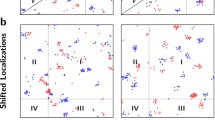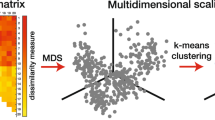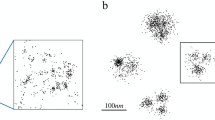Abstract
We present a method to robustly discriminate clustered from randomly distributed molecules detected with techniques based on single-molecule localization microscopy, such as PALM and STORM. The approach is based on deliberate variation of labeling density, such as titration of fluorescent antibody, combined with quantitative cluster analysis, and it thereby circumvents the problem of cluster artifacts generated by overcounting of blinking fluorophores. The method was used to analyze nanocluster formation in resting and activated immune cells.
This is a preview of subscription content, access via your institution
Access options
Subscribe to this journal
Receive 12 print issues and online access
$259.00 per year
only $21.58 per issue
Buy this article
- Purchase on Springer Link
- Instant access to full article PDF
Prices may be subject to local taxes which are calculated during checkout



Similar content being viewed by others
References
Sauer, M. J. Cell Sci. 126, 3505–3513 (2013).
Sage, D. et al. Nat. Methods 12, 717–724 (2015).
Annibale, P., Scarselli, M., Kodiyan, A. & Radenovic, A. J. Phys. Chem. Let. 1, 1506–1510 (2010).
Rubin-Delanchy, P. et al. Nat. Methods 12, 1072–1076 (2015).
Sengupta, P. et al. Nat. Methods 8, 969–975 (2011).
Fricke, F., Beaudouin, J., Eils, R. & Heilemann, M. Sci. Rep. 5, 14072 (2015).
Levet, F. et al. Nat. Methods 12, 1065–1071 (2015).
Garcia-Parajo, M.F., Cambi, A., Torreno-Pina, J.A., Thompson, N. & Jacobson, K. J. Cell Sci. 127, 4995–5005 (2014).
Lillemeier, B.F. et al. Nat. Immunol. 11, 90–96 (2010).
Rossy, J., Owen, D.M., Williamson, D.J., Yang, Z. & Gaus, K. Nat. Immunol. 14, 82–89 (2013).
Sherman, E. et al. Immunity 35, 705–720 (2011).
Ehmann, N. et al. Nat. Commun. 5, 4650 (2014).
Annibale, P., Vanni, S., Scarselli, M., Rothlisberger, U. & Radenovic, A. Nat. Methods 8, 527–528 (2011).
Annibale, P., Vanni, S., Scarselli, M., Rothlisberger, U. & Radenovic, A. PLoS One 6, e22678 (2011).
Whelan, D.R. & Bell, T.D.M. Sci. Rep. 5, 7924 (2015).
Burgert, A., Letschert, S., Doose, S. & Sauer, M. Histochem. Cell Biol. 144, 123–131 (2015).
Tanaka, K.A.K. et al. Nat. Methods 7, 865–866 (2010).
Sochacki, K.A., Shtengel, G., van Engelenburg, S.B., Hess, H.F. & Taraska, J.W. Nat. Methods 11, 305–308 (2014).
Cambi, A. et al. Mol. Biol. Cell 17, 4270–4281 (2006).
Paster, W. et al. J. Immunol. 182, 2160–2167 (2009).
Brameshuber, M. et al. J. Biol. Chem. 285, 41765–41771 (2010).
van de Linde, S. et al. Nat. Protoc. 6, 991–1009 (2011).
Schwarzenbacher, M. et al. Nat. Methods 5, 1053–1060 (2008).
Ovesný, M., Křížek, P., Borkovec, J., Švindrych, Z. & Hagen, G.M. Bioinformatics 30, 2389–2390 (2014).
Ripley, B.D. J. Royal Stat. Soc. 39, 172–212 (1977).
Acknowledgements
This work was supported by the Austrian Science Fund (FWF projects P 26337-B21 (G.J.S.), P 25730-B21 (G.J.S.), W1250-B20 (G.J.S.) and P 27941-E28 (F.B.)) and by the Austrian Research Promotion Agency (FFG project number 842379 (J.W.)). We would like to thank J. Huppa for critical reading of the manuscript and helpful comments throughout this study. We are further grateful to members of the Huppa, Stockinger and Schütz labs for valuable discussions. We acknowledge E. Parkinson and C. Donner for support with cell culture and cell sorting. We acknowledge G. Nolan (Stanford University) for originally providing retroviral plasmids (pBMN-Z and helper plasmids).
Author information
Authors and Affiliations
Contributions
F.B., K.L., A.M.A. and K.S. performed experiments; F.B. analyzed the data; A.M.A. and K.L. wrote the code for the analytical methods; A.M.A. wrote the code for the simulations; M.F. implemented Ripley's K analysis; H.S. and J.W. provided cell lines and materials; F.B., A.M.A. and G.J.S. developed the analytical method and conceived the simulations; F.B. and G.J.S. wrote the manuscript.
Corresponding authors
Ethics declarations
Competing interests
The authors declare no competing financial interests.
Integrated supplementary information
Supplementary Figure 1 Ripley’s K analysis may sense clustering in data from randomly distributed blinking molecules.
Ripley’s K analysis was performed on simulated localization patterns as shown in Fig. 1. Results for random distributions (gray line) and clustered distributions (black line) are shown at localization densities of ~50 locs/µm2 (a), ~500 locs/µm2 (b) and ~1,000 locs/µm2 (c). The dashed line was derived from analyzing a simulated random distribution of single localizations assuming similar localization densities as in the simulations for blinking molecules (ground truth for randomly distributed point patterns).
Supplementary Figure 2 Principle of density-dependent cluster detection.
(a) Each localization was represented by a 2D Gaussian function with fixed standard deviation σ (blue line). The Gaussians were added up (dashed green line) to serve as a measure of the local density of localizations. A threshold (dashed red line) was used to create a binary cluster mask. (b) To reduce overestimation of cluster sizes, 2D Gaussians were set to zero beyond a radius of 2σ. (c) Effect of different thresholds on cluster masks. Low thresholds (e.g. thr = 0.5) lead to overestimation of the clustered area. High thresholds (e.g. thr = 4.5) exclude localizations that belong to an apparent cluster and underestimate the clustered area. If not noted otherwise, an intermediate threshold thr = 2.5 was used for quantitative cluster analysis.
Supplementary Figure 3 Normalization of ρ/η plots renders the method applicable to a wide range of experimental conditions and analysis settings.
(a) Normalized data from simulations of randomly distributed blinking molecules that were assumed to show varying blinking statistics (2 blinks, 7 blinks or 25 blinks) or were analyzed at different thresholds (thr = 0.5, thr = 2.5 or thr = 4.5). All data converge to a single line, which was taken as reference curve in the following plots (red line; see Methods). (b) Normalized data from simulations of clustered molecules (3 clusters/µm²; cluster radius = 50 nm), where blinking statistics and analysis thresholds were varied as in a. (c, d) Different numbers of reappearances from the same fluorophore shift the off-set (ρ0) of ρ/η plots of randomly distributed (c) and clustered (d) data. (e, f) The effect of a high (thr = 4.5), an intermediate (thr = 2.5) and a low threshold (thr = 0.5) on quantitative cluster analysis of randomly distributed (e) and clustered (f) data. Different thresholds for cluster detection shift the off-set (ρ0) of the ρ/η plots. If not varied, we assumed seven observations per molecule and the analysis was done at an intermediate threshold (thr = 2.5). Lines show polynomial fits of the respective datasets (see Methods).
Supplementary Figure 4 Effect of residual diffusion and of molecules with different blinking statistics on the reference curve for random distribution; robustness and sensitivity of the method.
(a) Residual diffusion of molecules can have a slight effect on the off-set (ρ0) of ρ/η plots for randomly distributed data. We simulated lateral diffusion with D = 1.1 × 10-5 µm² at the indicated delays between consecutive images and total numbers of recorded frames. (b) After normalization the data points are well aligned on the reference curve for randomly distributed molecules (red line). In (c) we added up to 5% of molecules following different blinking statistics (mean of 100 localizations per molecule versus mean of seven localizations per molecule for the bulk fraction). A shift in the off-set (ρ0) of ρ/η plots can be observed, and a spread of the data at low η values. (d) Normalization aligns the data to the reference curve for randomly distributed molecules (red line). A noticeable spread at low η values, however, still remains. (e) variation of the number of clusters/µm² (cluster radius = 50 nm); (f) variation of the cluster radius (3 clusters/µm²); (g) variation of unspecific non-clustered background with the same blinking statistics as clustered molecules (seven observations per molecules); clusters were adjusted to 3 clusters/µm2 at a cluster radius of 50nm. (h) The sensitivity to detect small oligomers was assessed by assigning localizations with increasing probability (from 10% to 70%) to pentameric clusters (10 clusters/µm2, i.e. 50 molecules/µm²) at varying levels of monomeric background molecules. Note the different scaling. If not indicated otherwise, we generally assumed seven observations per molecule, thr = 2.5 (intermediate threshold), and an unspecific background of 1:4 in all simulations.
Supplementary Figure 5 dSTORM of endogenous CCPs and Lck at varying antibody concentrations.
Jurkat T cells were stained with AF647-labeled clathrin-HC-specific (a) or Lck-specific (b) antibodies at the indicated concentrations and imaged via dSTORM (upper panels). Yellow boxes indicate subregions that were enlarged (lower panels). Scale bars correspond to 1 µm. Cells are representative of 3-5 independent experiments.
Supplementary Figure 6 Quantification of the degree of antibody labeling.
Binding of (a) anti-clathrin-HC-AF647, (b) anti-LFA-1-AF647, (c) GFP-Trap-AF647 or (d) anti-Lck-AF647 at the indicated concentrations was quantified by TIRF microscopy. Normalized binding curves are shown. The data point at the highest concentration also indicates the highest concentration used for the respective antibody titration experiments. For each data point 15-20 cells were imaged. Data points are means. Error bars indicate s.e.m. Data are representative for 3 independent experiments.
Supplementary Figure 7 Apparent protein clustering due to inhomogeneous stochastic blinking.
JCaM1.6 cells stably expressing Lck-mEOS3.2 were stained with anti-Lck-AF647 to obtain a diffraction-limited image of the Lck distribution at the plasma membrane. On the same cell, PALM was performed to create a superresolution image of Lck-mEOS3.2 (center). Based on the localization map, a pseudo-diffraction limited image was reconstructed (right). For the reconstruction, we assumed a Gauss blur with a σ-width of 100 nm. Yellow boxes indicate subregions that were enlarged (lower panels). Scale bars correspond to 1 µm. A representative cell of > 50 is shown.
Supplementary Figure 8 Quantitative cluster analysis of Lck-mEOS3.2 under activating conditions.
(a) PALM imaging and quantitative cluster analysis was carried out on activated JCaM1.6 cells stably expressing Lck-mEOS3.2. A normalized ρ/η plot is shown. Each data point represents a single cell; three independent experiments were included in the graph. The red line indicates the reference curve for a random distribution. (b) Ca2+ mobilization in JCaM1.6 cells stably expressing Lck-mEOS3.2 was measured via Fura-2 ratiometric imaging. Cells were seeded on glass slides coated with fibronectin (black trace) or CD3ɛ-specific (OKT3) antibody (red trace). Data are representative for 3 independent experiments.
Supplementary information
Supplementary Text and Figures
Supplementary Figures 1–8 and Supplementary Note (PDF 1350 kb)
Supplementary Software
clustermask_createset.m performs quantitative cluster analysis and generates normalized ρ/η plots to probe (d)STORM or PALM data for protein nanoclustering. (ZIP 5143 kb)
Rights and permissions
About this article
Cite this article
Baumgart, F., Arnold, A., Leskovar, K. et al. Varying label density allows artifact-free analysis of membrane-protein nanoclusters. Nat Methods 13, 661–664 (2016). https://doi.org/10.1038/nmeth.3897
Received:
Accepted:
Published:
Issue Date:
DOI: https://doi.org/10.1038/nmeth.3897
This article is cited by
-
LFA-1 nanoclusters integrate TCR stimulation strength to tune T-cell cytotoxic activity
Nature Communications (2024)
-
Photoswitching fingerprint analysis bypasses the 10-nm resolution barrier
Nature Methods (2022)
-
Approach to map nanotopography of cell surface receptors
Communications Biology (2022)
-
Correction of multiple-blinking artifacts in photoactivated localization microscopy
Nature Methods (2022)
-
High-precision estimation of emitter positions using Bayesian grouping of localizations
Nature Communications (2022)



